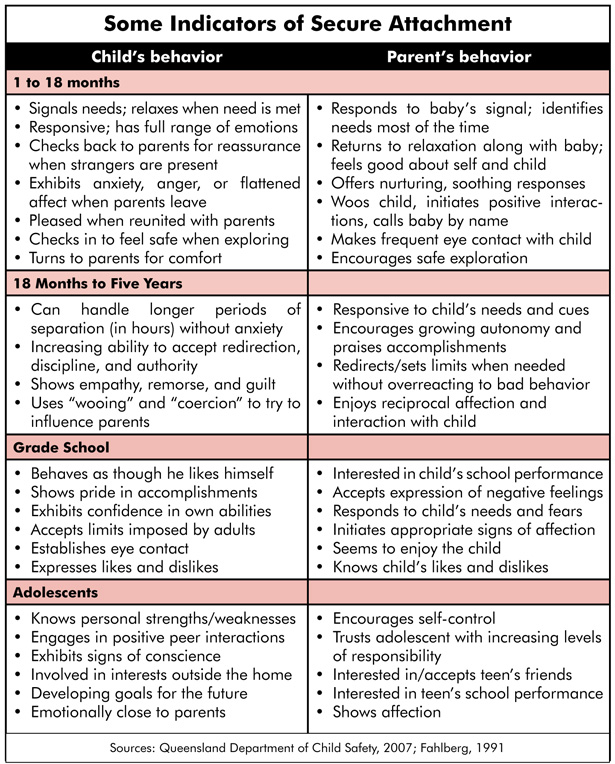 |
 |
 |
Vol.
19, No. 3
July 2014
Why Attachment Matters
Most of us are aware attachment is an important part of healthy development. Yet we may not know exactly why attachment is so important or understand how secure attachment occurs.
Secure Attachment
Attachment occurs when a child has a secure, consistent, reciprocal relationship with a preferred person--typically the child's primary caregiver. When the caregiver is sensitive to the child's needs and responds in ways that are warm, nurturing, and make the child feel safe, the child begins to use this person as a secure base from which to explore and, when necessary, as a haven of safety and comfort (Waters & Cummings, 2000 cited in Benoit, 2004; Moulin, et al., 2014).
If a caregiver is consistently available, responsive, and nurturing, by the final months of the first year the child's attachment to that person is very likely to be "secure," meaning the child is confident the caregiver will always be available to help or save them (Bowlby, 1982; Wolpert, 1999).
Attachment matters. Although it's most obvious when we're young, its powerful influence is felt throughout our lives.
Benefits of Secure Attachment
Secure attachment has been linked to many positive child outcomes, including:
Brain Development. The brain grows rapidly during the first three years of life. Experiences shape how the brain grows. When it is stimulated in positive ways, the brain forms connections related to those experiences. For example, talking, singing, and reading to children help form brain pathways related to language.
Attachment affects brain development in two important ways. First, because the child feels safe and cared for, the brain can use its energy to develop pathways crucial for higher level thinking. Secure attachment is particularly related to the development of the frontal cortex, which is responsible for decision making, judgment, and reasoning (DeBellis & Thomas, 2003; Dozier, et al., 2008).
Second, by providing a "home base" from which a child can safely explore the world, secure attachment allows the child to have more varied experiences and therefore build more connections in the brain.
Social & Emotional Development. Attachment to a primary caregiver is the foundation of all future relationships. When there is a secure attachment, you learn how to trust others, how to respond emotionally, and how others will respond to you (Bowlby, 1982).
In addition, secure attachment leads to the development of empathy. If a child sees herself as worthwhile and deserving of care, she is also able to see others that way. Only when a child believes her own basic needs will be met can she attend to others' needs. The child works first to please her primary caretaker and over time extends her concerns to siblings, friends, classmates, community members, and, as her moral development continues, to people she has never met.
Self-Regulation. When caregivers respond to them, infants learn to manage their own feelings and behavior. When infants are overwhelmed, stress hormones are released in the brain. When caregivers respond with soothing behaviors, they help the child reduce these hormones.
Over time, the brain develops pathways that allow this soothing behavior to kick in during periods of stress. Eventually the child is able to calm themselves when they are angry or disappointed.
Trauma and Attachment
Inherent in the trauma of child abuse and neglect are experiences of fear, stress, and rejection by the very person who is supposed to protect and soothe the child. Because these emotional experiences are in direct conflict with the experiences that promote attachment, it follows that children with a history of maltreatment often have attachment problems.
Children with trauma histories may have a wide range of problems related to lack of secure attachment; these include developmental delays, difficulty with emotional regulation, impaired social relationships, aggression, low self-esteem, and depression (Hildyard & Wolfe, 2002; Erickson & Egeland, 2002; Shipman, et al., 2005).
Supporting Secure Attachment
As a child welfare worker you are in a position to help support secure attachment with both biological and resource parents. Here's how:
Educate. Make sure caregivers know why secure attachment matters and the behaviors that build it. Messages to send include (Dozier, et al., 2008; Wittamer, 2011):
- Be responsive and warm
- Respond to children's needs
- Soothe children in distress
- Learn to read and respond to children's cues
- Spend time together (quantity matters)
- Engage in positive physical contact (hugging, singing, holding, etc.)
- Play with children, specifically in activities that support reciprocity.
Provide concrete supports. Overwhelmed caregivers have difficulty focusing on the needs of children and are not as effective at reading and responding to cues. Providing concrete supports and resources that help caregivers manage stress allows them to focus on their children's needs.
In addition, young and inexperienced parents may need to build their knowledge of parenting and child development. Although parenting programs can help with this, they are not all alike. Look for programs, such as the Incredible Years, Attachment and Biobehavioral Catch-Up, and Circle of Parents, that have a specific focus on cultivating skills that build attachment (Wittamer, 2011).

